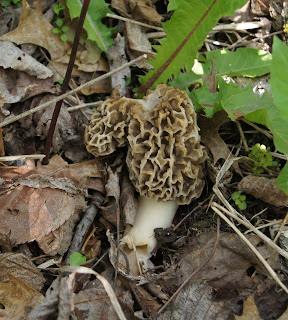It is a mighty mushroom indeed that compels the sort of fanatical pursuit that morchella esculenta inspires. It's a rite of spring that sends hordes out into the ticky woods to scour the underbrush for the chance to spy that unique honeycomb cap in the moss or pushing through brown leaves. A lot of morel hunters don't bother to hit the woods for any other mushroom, or any other wild food. The spring pursuit is their only foraging interest. I attribute this to the fact that 1) It is a rite of spring, a ceremony of the season, 2) Morels can be fairly predictable, 3) Morels can be extremely abundant, 4) Morels are easily preserved by drying, and 5) They are easily identified, with no really harmful look-alikes. I don't think that it's because they are fantastically delicious. They're good, sure, but on my list they fall below chanterelles, black trumpets, and hen of the woods. For me, the hunt is the thing, and it is incredibly thrilling to slog over steep terrain, poke under currant bushes, probe beneath peeled bark, and finally be rewarded with the sight of that unique shape. I keep going back, even though I rarely have much success.
This year is looking like a very good one for morels here in Minne'Sconsin (I may have to edit that moniker somehow, now that I live in Wisconsin full-time--Wis'Sota?). I know it's a good year, because even I am finding them. I've brought home a couple of pounds from the Bide-A-Wee woods so far. My main haul came from a dead elm on a south-facing slope. I look for trees that have been dead long enough that the bark is starting to peel quite a bit. If I do spot a morel, then I step very carefully, and scan the ground assiduously, for a morel can seem to disappear from view even as you are looking at it. From the base of the tree out to the edge of the dripline is where the morels will sprout; this Bide-A-Wee tree was a good example of that. They were mostly downhill from the tree. I went back a couple of times after my first find, and continued to find morels. In fact, I managed to find a couple that I apparently had stepped on without noticing it on a previous foray:
And one that was completely hidden under a slab of bark:
I have always heard that morels are often found near apple trees, which I consider very good news indeed, because there are apple trees all over the Bide-A-Wee land; the bad news was that I had never once found a morel anywhere near an apple tree. Until yesterday. I was on my way back to the cabin, sweaty on an unexpectedly hot afternoon, prickly ash- and bramble-scratched, and I turned up that particular hillside just to stay in the shade. Luckily I was still in ground-scanning mode, and the morels were quite conspicuous. I wasn't really consciously looking and I stepped right over a couple of large morels, before noticing a couple of nice ones in the moss near the trunk.
Then I went and checked under the other apple trees in the area. Nada. Morels are just that way.
Collateral benefits to the morel hunt include spotting the first showy trilliums blooming on our land:
 |
| The entire young plant, stem and all, is delicious simply steamed and tossed with butter. |
One thing we have done with this spring's finds, a rabbit and morel hash on fried polenta:
The recent warm wet weather will add an air of urgency to the hunt. Conditions for morel emergence are perfect, but in the hot and damp they won't last long out there. Get 'em while you can.
Text and photos copyright 2012 by Brett Laidlaw









3 comments:
I agree.
You basically already said this, BUT: In regards to why beginning foragers hunt morels and not other mushrooms I would add, the morel window is easier to spot because it comes with something we notice anyway: spring. With chanterelles arriving some time in late summer/early fall it's hard to pinpoint when one might go looking.
Congrats. Those look so pretty, too.
Dang, our morel year was a bust, but our friends 10 miles south of us didn't even have to look: they noticed them outside their deck and then a HUGE patch (we're talking grocery bag full) next to their garage. I hated them until they gave me about a pound :)
Interesting that you did them with rabbit! What a rich dish!
Good points, Martha. The world of foraging is big enough--literally--and daunting enough, that any little foothold for beginners is a help. Also, morels do have this odd and charming habit of turning up in people's lawns, as they did here yesterday, in abundance. But we also had them a couple of years at both our Saint Paul houses. I've added cottonwoods to my list of likely morel host trees.
For more evidence of this phenomenon, see El's friends. The rabbit hash was a creative use of leftovers. Original was rabbit and morels in cream. Morels and cream is classic French, and one of my favorite ways to use them.
Cheers~ Brett
Post a Comment